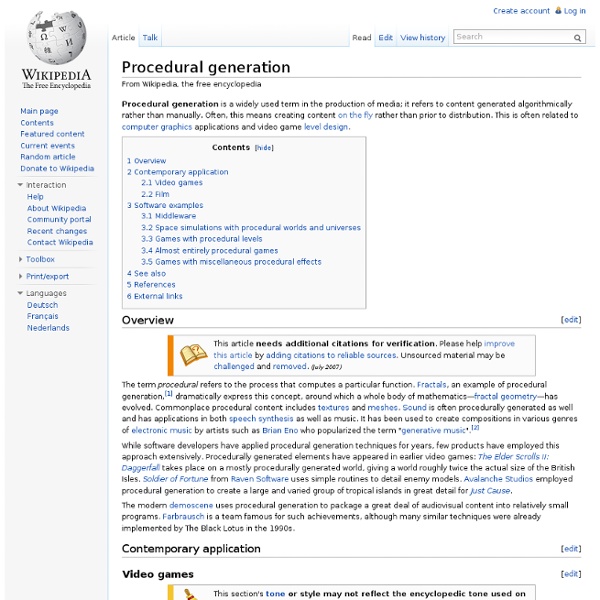The Death of the Level Designer: Procedural Content Generation in Games - Part One
(This article is in six parts: parts one, two , three, four, five and six, along with a follow up article series Proceduralism; and is also available as a PDF) Procedural content generation is yet to set the game industry on fire. It has featured in one of the greatest games of all time, Diablo and it's successor, who directly trace their roots to roguelike games such as Angband. An announcement late last year should have set the hearts of anyone working in the games industry a tremor. This article will survey the current scope of procedural content generation in order to highlight where PCG is making inroads into the traditional level designer roles, and how various enabling technologies are making procedural content easier to build and deploy within other game technologies. Procedural content generation (PCG) is the programmatic generation of game content using a random or pseudo-random process that results in an unpredictable range of possible game play spaces. 1. 2. 3.
CityEngine | 3D Modeling Software for Urban Environments
Menu Products Esri CityEngine Transform 2D GIS data into smart 3D city models. 30-Day Free Trial → Main Features Getting Started Industries Pricing Try It Free Design a Smarter City Esri CityEngine improves urban planning, architecture, and design. Watch the Video: Build Smart 3D Cities “Turning Zoning laws with CityEngine into vivid three dimensional visualizations, is drastically changing the way we understand and plan our sustainable future environments.” Niels Lehmann, Urban Synergy Group Build Flexible Scenarios Faster Compare and analyze building proposals from every angle. Create Realistic Context See where a proposed building blocks the view, casts shadows, and reflects heat. Share Your Urban Plan Publish your 3D model online. Sign up for a free trial. Esri Home » Products Follow Us Contact Us | Privacy | Legal | Site Map
indiedev - Die Community für Spieleentwickler
Quad Software | Technology that makes it simple
Consortium | Open Standards for Real-Time 3D Communication
The German 3D software developer Bitmanagement Software GmbH who are in the board of directors of the Web3D Consortium in Mountain View, California, USA has released the new authoring tool "BS Content Studio", which enables a wide audience to create interactive and Internet ready 3D content. This tool will sustainable accelerate and simplify the work-flow and time necessary to compose, animate and optimize 3D models and interactive content for the web and standalone applications. Even "non 3D specialists” can be now in the position to generate 3D real-time applications easily. The "BS Content Studio" Tool addresses a horizontal market and has been developed around the Web3D ISO standard X3D with the goal to enable a broad range of application domains including CAD, GIS, games, process automation, 3D printing, virtual catalogs, 3D marketing banners, configurators, product visualization, automation, augmented reality, stereo TV content, social communication and many more.
X3D
Rozszerzenie X3D wspiera wielostopniowy i wieloteksturowy rendering, ono także obsługuje cieniowanie w oparciu o lightmap i normalmap. W 2010 X3D wspiera odroczone architektury renderingu. Teraz X3D może importować SSAO i CSM i Realtime Environment Reflection/Lighting, ale nie musi troszczyć się dużo o liczbę wielokątów. Użytkownik może również używać optymalizacji jak BSP/QuadTree/OctTree lub cullingu w scenie X3D. X3D może współdziałać z innymi standardami Open Source, takimi jak XML, DOM i XPath. Standaryzacja[edytuj | edytuj kod] X3D definiuje szereg profili (zestawów komponentów) dla różnych poziomów obsługi, takich jak X3D Core, X3D Interchange, X3D Interactive, X3D CADInterchange, X3D Immersive, X3D Geospatial i X3D Full. Współpraca i porozumienia o współpracy są także na miejscu pomiędzy Web3D Consortium i World Wide Web Consortium (W3C), Open Geospatial Consortium (OGC), Digital Imaging and Communications in Medicine (DICOM) i Khronos Group. Aplikacje[edytuj | edytuj kod] Przypisy
SpeedTree® | Welcome
User Guide: Intro
Published: November 5, 2010 for Houdini 11 [Scroll down for Video] The creation of 3D animation and visual effects involves a number of stages which come together to create a complete artistic vision. Throughout this process, 3D artists like yourself explore and refine ideas in order to meet the creative needs of the project while hitting many tight deadlines. With Houdini, you have access to a node-based procedural workflow which makes it easier to manage and control the underlying flow of data which defines how your models, materials, animation and visual effects are working. This control makes it easier to step in and make changes where needed as the nodes update to show the new results. This frees you up to explore and prototype ideas early in production then come back and refine and scale the solution to create final shots. What you will learn from this Guide... If you are new to the 3D world then Houdini is a great package to start with. Video Overview:



